The name of this pub recalls the Muckle Cross which, in medieval times, stood at the heart of Elgin. A second cross was erected in 1630, surmounted by a lion. A copy of this cross was re-erected in the late 1880s, with the original lion.
Prints and text about The Muckle Cross.
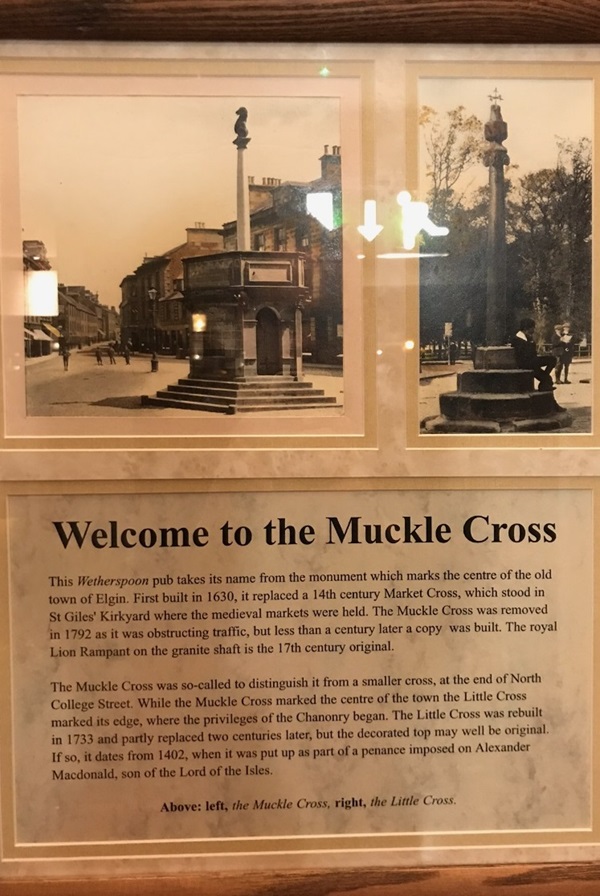
The text reads: This Wetherspoon pub takes its name from the monument which marks the centre of the old town of Elgin. First built in 1630, it replaced a 14th century Market Cross, which stood in St Giles’ Kirkyard where the medieval markets were held. The Muckle Cross was removed in 1792 as it was obstructing traffic, but less than a century later a copy was built. The royal Lion Rampant on the granite shaft is the 17th century original.
The Muckle Cross was so-called to distinguish it from a smaller cross, at the end of North College Street. While the Muckle Cross marked the centre of the town the Little Cross marked its edge, where the privileges of the Chanonry began. The Little Cross was rebuilt in 1733 and partly replaced two centuries later, but the decorated top may well be original. If so, it dates from 1402, when it was put up as part of a penance imposed on Alexander Macdonald, son of the Lord of the Isles.
Above: left, the Muckle Cross, right, the Little Cross.
An illustration and text about local landmark.
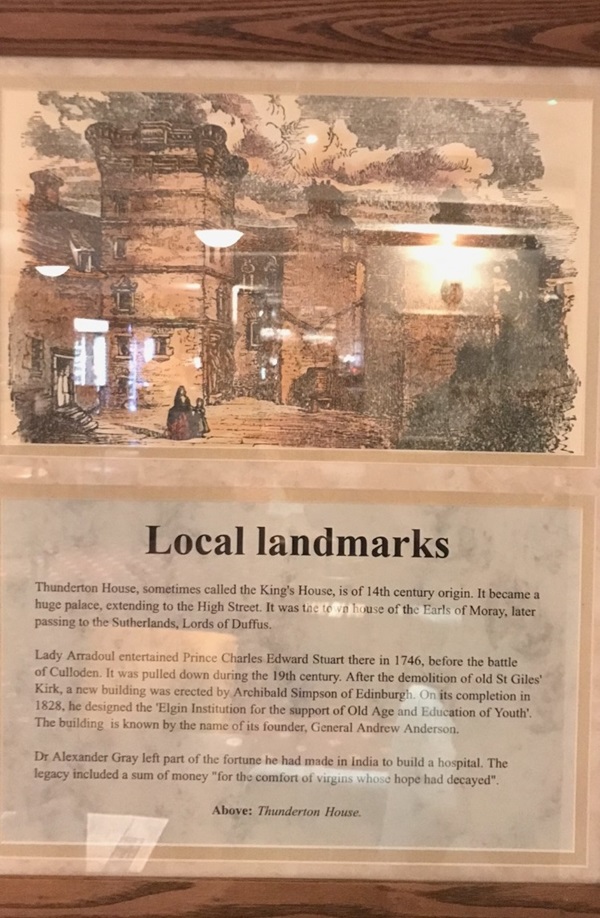
The text reads: Thunderton House, sometimes called the King’s House, is of 14th century origin. It became a huge palace, extending to the High Street. It was the town house of the Earls of Moray, later passing to the Sutherlands, Lords of Duffus.
Lady Arradoul entertained Prince Charles Edward Stuart there in 1746, before the battle of Culloden. It was pulled down during the 19th century. After the demolition of old St Giles’ Kirk, a new building was erected by Archibald Simpson of Edinburgh. On its completion in 1828, he designed the Elgin Institution for the support of Old Age and Education of Youth. The building is known by the name of its founder, General Andrew Anderson.
Dr Alexander Gray left part of the fortune he had made in India to build a hospital. The legacy included a sum of money “for the comfort of virgins whose hope had decayed”.
Above: Thunderton House
Photographs and text about James Ross.
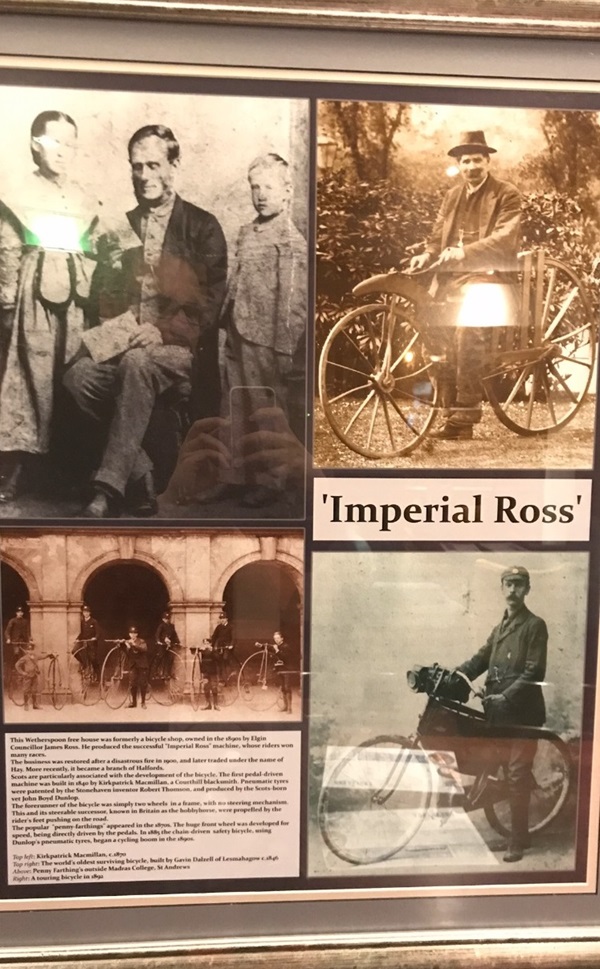
The text reads: This Wetherspoon free house was formerly a bicycle shop, owned in the 1890s by Elgin Councillor James Ross. He produced the successful “Imperial Ross” machine, whose riders won many races.
The business was restored after a disastrous fire in 1900, and later traded under the name of Hay. More recently, it became a branch of Halfords.
Scots are particularly associated with the development of the bicycle. The first pedal-driven machine was built in 1840 by Kirkpatrick Macmillan, a Courthill blacksmith. Pneumatic tyres were patented by the Stonehaven inventor Robert Thomson, and produced by the Scots-born vet John Boyd Dunlop.
The forerunner of the bicycle was simply two wheels in a frame, with no steering mechanism. This and its steerable successor, known in Britain as the hobbyhorse, were propelled by the rider’s feet pushing on the road.
The popular penny-farthings appeared in the 1870s. The huge front wheel was developed for speed, being directly driven by the pedals. In 1885 the chain-driven safety bicycle, using Dunlop’s pneumatic tyres, began a cycling boom in the 1890s.
Top left: Kirkpatrick Macmillan, c1870
Top right: The world’s oldest surviving bicycle, built by Gavin Dalzell of Lesmahagow c1846
Above: Penny Farthing’s outside Madras College, St Andrews
Right: A touring bicycle in 1892
Illustrations and text about the Elgin Marbles.
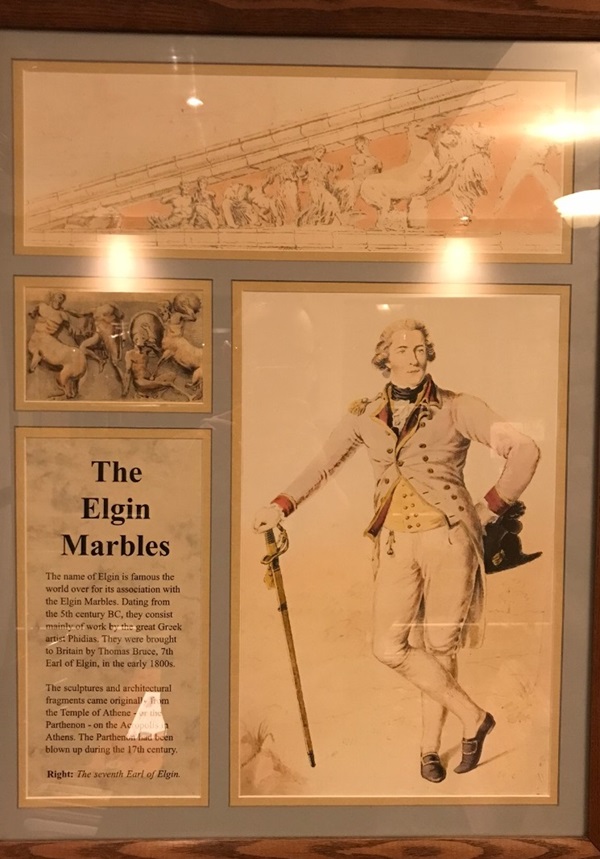
The text reads: The name of Elgin is famous the world over for its association with the Elgin Marbles. Dating from the 5th century BC, they consist mainly of work by the great Greek artist Phidias. They were brought to Britain by Thomas Bruce, 7th Earl of Elgin, in the early 1800s.
The sculptures and architectural fragments came originally from the Temple of Athene – or the Parthenon – on the Acropolis in Athens. The Parthenon had been blown up during the 17th century.
Right: The seventh Earl of Elgin.
Photographs and text about Elgin Castle.
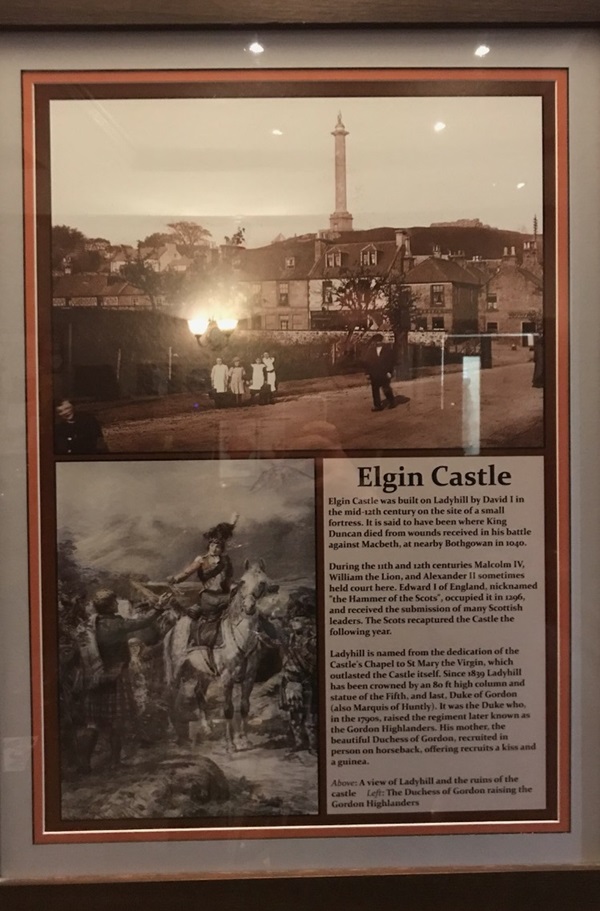
The text reads: Elgin Castle was built on Ladyhill by David I in the mid-12th century on the site of a small fortress. It is said to have been where King Duncan died from wounds received in his battle against Macbeth, at nearby Bothgowan in 1040.
During the 11th and 12th centuries Malcolm IV, William the Lion, and Alexander II sometimes held court here. Edward I of England, nicknamed “the Hammer of the Scots”, occupied it in 1269, and received the submission of many Scottish leaders. The Scots recaptured the Castle the following year.
Ladyhill is named from the dedication of the Castle’s Chapel to St Mary the Virgin, which outlasted the Castle itself. Since 1839 Ladyhill has been crowned by an 80ft high column and statue of the Fifth, and last, Duke of Gordon (also Marquis of Huntly). It was the Duke who, in the 1790s, raised the regiment later known as the Gordon Highlanders. His mother, the beautiful Duchess of Gordon, recruited in person on horseback, offering recruits a kiss and a guinea.
Above: A view of Ladyhill and the ruins of the castle
Left: The Duchess of Gordon raising the Gordon Highlanders.
Illustrations of St Giles.
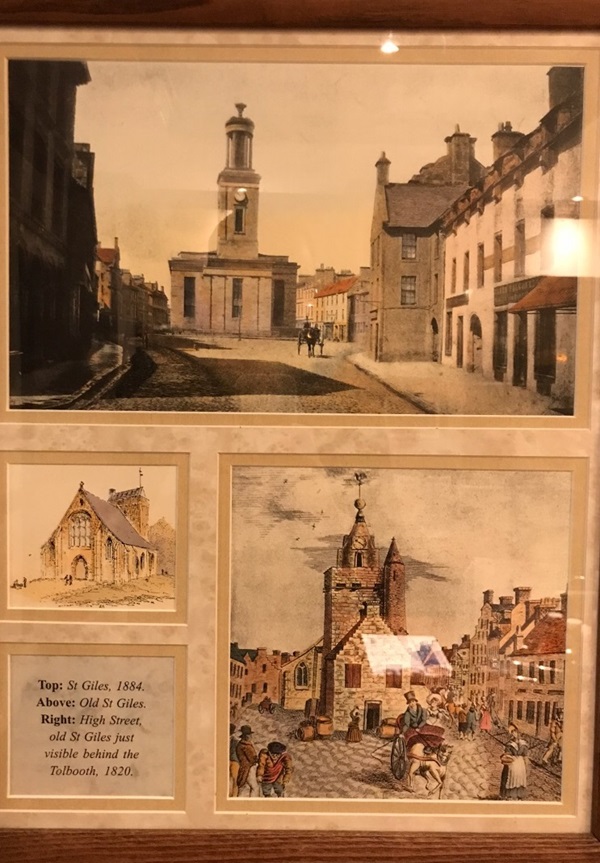
Top: St Giles, 1884
Above: Old St Giles
Right: High Street old St Giles just visible behind the Tolbooth, 1820.
If you have information on the history of this pub, then we’d like you to share it with us. Please e-mail all information to: pubhistories@jdwetherspoon.co.uk